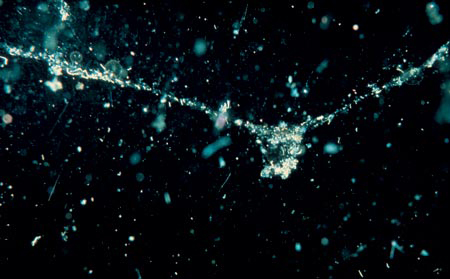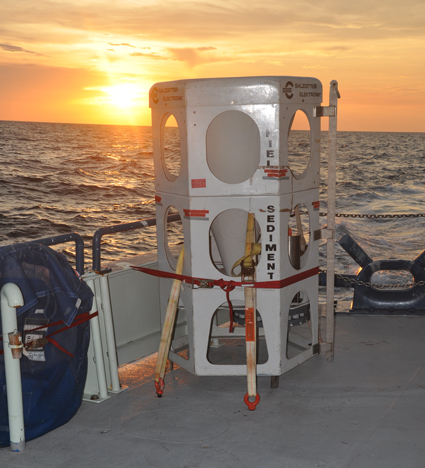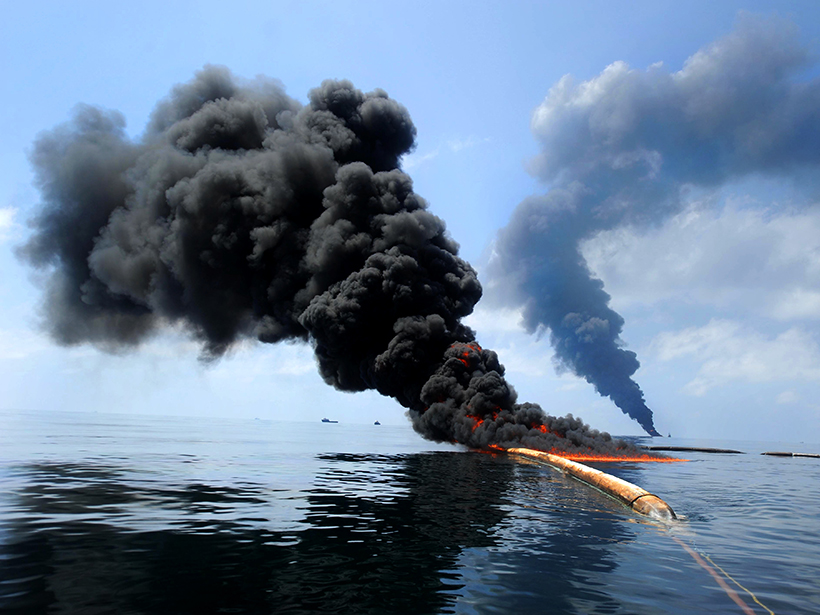By the time British Petroleum (BP) managed to cap the leaking Deepwater Horizon oil well in July 2010, the broken drill pipe had spewed an estimated 3.2 million barrels of crude oil into the northern Gulf of Mexico. New findings reveal that oil from the spill remained in the water column for 5–7 months after the spill was capped, even though sampling projects at the time found only trace amounts of oil in the water. What’s more, organic debris in the water, known as marine snow, played a major part in concentrating lingering oil beneath the waves and then slowly pulling it and other pollutants from the disaster down to the seafloor.
“Even after oil was mostly undetectable in the water, it was entering the food chain at many levels of the ocean.”
The findings, published Monday in the Proceedings of the National Academy of Sciences, show for the first time that marine snow events can interact with oil and transport it to ocean floor ecosystems, the researchers said. “Even after oil was mostly undetectable in the water, it was entering the food chain at many levels of the ocean,” said Columbia University chemist Beizhan Yan, who led the analytic chemistry component of the research from his lab at the Lamont-Doherty Earth Observatory in Palisades, N.Y.
What Is Marine Snow?

Made of decayed algae, or plankton parts, sand, and other detritus in the water, feathery bits of marine snow filter downward from surface waters to the seafloor much like snowflakes fall from the winter sky. In what scientists call a marine snow event, these morsels fall copiously over the course of many days, similar to a blizzard.
In the northern Gulf of Mexico, diatom blooms occur frequently because of nitrate and phosphate nutrients from agriculture released into the gulf by the Mississippi River. Marine snow events often occur when these blooms die. Marine snow serves as a carbon and nitrogen source for scavengers and is a primary food source for organisms living in deep waters where almost no sunlight reaches.
Prior to the BP spill, oceanographers had studied the components and durations of marine snow events, but not the potential role of underwater blizzards in transporting oil.
Oil from the Surface, Found in the Deep
After the disaster struck, University of California, Santa Barbara oceanographer Uta Passow, a coauthor of the new paper, suspected that the sinking marine snow might concentrate oil as it filtered from surface to deep waters.
“A colleague was doing research during the spill, and he sent a picture of a marine snow event near the oil. Right away I worried that this would sink the oil,” said Passow.
Like the thin layer of oil that forms at the top of a bottle of salad dressing, crude oil was thought to rise toward the surface. Yet within a couple of months after the disaster began, in April 2010, responders noted that a long, thick plume of oil had accumulated downstream of the wrecked rig at about 1000-meter depth. Moreover, responders also saw, to their surprise, coatings of lightweight BP oil deposited on the ocean floor in some areas.
The oil continued to accumulate after the leak was capped in mid-July, even though most waters tested clean.
Dirty Blizzards
Oil spill response teams don’t monitor marine snow, but Passow wondered if oil droplets clinging to the bits of debris—a dirty blizzard—might have reconcentrated residual pollutants, helping explain the oil on the ocean floor.
To collect any oil accumulating in the blizzard, Passow and other scientists anchored a funnel-shaped sediment trap just above the ocean floor about 6.5 kilometers southwest of the capped well. Starting at the end of August 2010, the device collected deposits of marine snow. Multiple marine snow events created sediment layers in the trap for more than a year, the researchers report.

Yan and other chemists then scanned samples for black carbon, a sign of burned oil from the oil rig. They also analyzed the sediments for olefins and barium, both additions to the drilling mud used to block gases and prevent explosions in the well. These markers helped distinguish oil from the spill from past leaks or natural seeps.
According to the findings, chemical markers of BP oil and drilling only began to tail off in the captured sediments starting in January 2011, some 6 months after the leak was capped.
These results may help scientists understand why the spill had such a widespread effect, said Charles Fisher, a biologist at Pennsylvania State University in University Park. “The marine snow mechanism explains how the oil reached corals at greater depths and much farther away. We found impacted corals at depths of 1800 meters and in locations that could not be explained by a plume of oil,” he said.
“People worry about the dolphins and birds, but we know very little about the impacts of an oil spill on deep water.”
Through marine snow, the effects of oil pollution find their way to all levels of the ocean, the new findings suggest. “People worry about the dolphins and birds, but we know very little about the impacts of an oil spill on deep water,” said Passow. Precipitating oil could harm many organisms that live in the sediment and corals, and more research is needed to understand the full scope of dirty marine snow on ocean floor ecosystems, she explained.
As a first step, Passow is now working with NOAA emergency teams to integrate marine snow sedimentation into response models.
—Amy Coombs, Eos News Reporting Intern; email: [email protected]
Citation:
Coombs, A. (2016), Deepwater Horizon oil lingered and sank, stuck to “marine snow”, Eos, 97, https://doi.org/10.1029/2016EO053651. Published on 03 June 2016.
Text © 2016. The authors. CC BY-NC-ND 3.0
Except where otherwise noted, images are subject to copyright. Any reuse without express permission from the copyright owner is prohibited.

